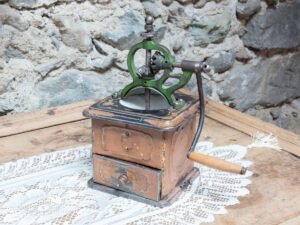With my years-long experience, I believe that most enthusiastic collectors run after the old, Stone Age-era antiques. And out of all of them, the 10,000 BCE stone heads attract them the most! Well, neither polished nor pointed, their solid stones and hand-shaped joints always catch the collectors’ eye!
But since people made them 10,000 years ago, stone axe heads are obviously very rare today! Besides, there’s no proper documentation on the age and materials that help users appraise them. So today, I’ll be sharing those tips with you!
Key Takeaways
- Most collectible stone axe heads are 5000 – 12,000 years old. So, ensure they have pointed edges, grooves, and inlay designs at the center.
- Antique stone axe heads have Flint, Obsidian, Basalt, Jadeite & Granite bodies, of which the Basalt ones are rare and precious.
- Vintage stone head axes with rough and unpolished finishes cost more due to their natural stone fractures & textures.
- Bored with the normal black stone axes? Collect triangular Green or Yellow stone heads for more variety!
How Do You Identify Old & Authentic Stone Axe Heads?

You can obviously spot these axe heads by their stone bodies and Strappi (small fractures). But if you want the precious ones, this features list will help you:
- Flint, Obsidian, Basalt, or Granite sides with crude, stone-chiseled edges
- Might have a pointed spike for digging & piercing
- Convex grooves to channel the surface water
- Might have simple floral, animal, leaf, or vine-shaped carvings
- Round and flattened poll (opposite edge of the axe)
- Crude rope or leather binders
Evolution & History of Antique Stone Head Axes
Let’s go back to 10,000 BCE, roughly 12,000 years from now! At that time, we didn’t have any cleavers or knives. So, the Stone Age man tied a sharp stone on a wooden log and used it for hunting. Well, that was the first stone head axe ever!
But this simple model needed better sharpness and grip. So, in the Neolithic and Mesolithic ages, man added jagged edges, toes, and heels to each. He even used local, polished stones like Jade and Jadeite for smooth and clear cuts.
However, by 1200 BCE, we had Iron & Bronze. And these metals were sharper and polished than stone. So, makers moved towards metal axe heads, making the stone ones rare today. You’ll still get some models till the 1600s, but those might be smaller and cheaper.
2 Types of Antique Stone Axe Heads (With Features & Costs)
Archaeologists have unearthed two main stone heads, each with different features and costs. So, let’s check those first:
1. Celt Stone Axe Heads
Celt stone axe heads work on sockets, butt-ends, and heels. They don’t have shaft holes but thin and pointed blades for chopping wood. Also, they might have painted patterns and symbols of the local tribes. Depending on the condition, these axe heads usually cost $50 – $4000.
2. Adze Stone Axe Heads
Adze stone axes are thick, perpendicular axes, costing $200 – 3000. You can spot them by their jagged edges, shaft holes, and curved blades. And since they are polished, you might see some yellow, green, or blue streaks on the blades.
6 Factors to Identify & Value Antique Stone Axe Heads
Now, let’s see how other factors like age, style, and colors affect your stone head axe’s resale value:
1. Age & Features
Do you know that antique stone axe heads had no specific shape or size? I mean, people literally used any natural rock, stick, or animal hide they could find to make it.
But even then, we have some era-specific tying methods & features that help track the axe’s age. Let’s discuss those:
| Antique Stone Axe Head Era | Average Age | Unique & Special Features | Estimated Value |
| Paleolithic Era (10,000 BCE) | 12,000 years | Rough & Unpolished Flint, Quartz, or Basalt blades with asymmetrical & uneven sections | $1000 – 4500 |
| Mesolithic Era (4000 BCE) | 6,000 years | Smooth Flint, Chert & Quartzite blades with small, bi-facial designs | $300 – 2000 |
| Neolithic Era (3000 BCE) | 5,000 years | Unifacial Jade, Nephrite & Hardstone blades with polished and refined surfaces | $80 – 1000 |
| Bronze Age (2000 BCE) | 4,000 years | Composite & Hybrid stone heads with Polished Bronze, Jade, or Serpentine streaks | $50 – 500 |
| Iron Age (1200 BCE) | 2,000 years | Small and chiseling axes with Wrought or Alloyed Iron handles, throats, and designer motifs | $20 – 200 |
Try to get old stone axe heads with fingernail-sized coarse Basalt edges for an old make.
2. Axe Head Materials

It’s not just basalt; The Stone Age man also used various other stones – Flint & Granite to make axes, especially in the 2000 BCE. Of these, the polished Flint ones cost more due to their sharpness, while the soft and brittle Obsidian ones are cheaper.
Check how the stone’s type affects the axe’s value below:
| Old Stone Axe Head Materials | Top Collectible Features | Average Cost |
| Flint / Chert | Sharp and Durable blades with jagged edges, easy-to-shape sections, and rough finishes | $20 – 150 |
| Obsidian | Glossy, cool-lava rocks with smooth surfaces, razor-sharp edges, and conchoidal fractures | $50 – 1200 |
| Basalt | Igneous rock blades with a dense, fine-grained structure, brushed finishes, and jagged blades. | $100 – 2000 |
| Jadeite & Nephrite | Greenish or Bluish blades with polished, high-luster finishes and singing edges | $100 – 900 |
| Granite | Granular blades with Quartz or Mica speckles, pointed blades, and brushed finishes | $70 – 500 |
Pick vintage stone axe heads with Hickory, Mahogany, Cherry, or Hornbeam (Carpinus Betulus) handles for more returns.
3. Styles
Surprisingly, all civilizations made old stone head axes around the globe. And people obviously didn’t use the same, tied design for all. Like, the Acheulean people used flint blades and symmetrical handles, while the Mayan people worked with Jade & Jadeite.
So, it’s all these unique features that impact a stone head axe’s cost! Let’s see how:
| Vintage Stone Axe Head Styles | Unique Traits | Estimated Cost |
| Acheulean Style | Flint or Chert heads with sharp cutting edges, symmetrical edges, and bifacial designs | $900 – 4000 |
| Mayan & Mesoamerican | Jade or Jadeite heads with detailed carvings, symbolic motifs, and jagged edges | $60 – 900 |
| Tibetan | Small, teardrop shape axe heads with a high-gloss finish & decorative or carved inlays | $800 – 2000 |
| Columbian | Rectangular or Oval axe heads with sharp, round butts and Granite or Basalt blades | $50 – 500 |
| Chinese | Trapezoidal or Triangular axe heads with regional Dragon or mesh carvings and Jade inlays | $30 – 700 |
4. Stone Axe Head Colors
One of the easiest ways to date a stone axe head is its colors. It’s so that the earliest 10,000 BCE axes were simply black or gray. But then, by 4000 BCE, makers had moved to other yellow and brown stones too! So, let’s see how to appraise such colored axes.
| Antique Stone Axe Head Colors | Estimated Value |
| Black (Solid or Speckled) | $1000 – 4500 |
| Light & Dark Gray | $700 – 3000 |
| Pale Green or Bluish Green (Jadeite) | $80 – 1000 |
| Earthy Tones – Brown & Beige | $40 – 600 |
| White or Yellowish White | $400 – 1800 |
5. Shapes
It’s true that the old, Paleolithic era axes were a bit crude and abstract. But then, by the Neolithic age, makers standardized the process and used simple triangle or adze blade shapes for a better cutting edge and grip.
Here’s a table with the top features of different axe head shapes and their costs:
| Vintage Stone Axe Head Shapes | Estimated Value |
| Tear-drop (Round & Pointed) | $200 – 4000 |
| Triangular | $500 – 2000 |
| Curved & Crescent | $100 – 900 |
| D or Unifacial shaped | $50 – 600 |
6. Axe Head Finishes
Take a clean cloth and rub it thoroughly on the stone axe head’s surface. Does it feel rough or poky? If yes, it might be an old, 10,000 BCE stone axe! But, if you find a smooth, waxy finish, it might be from 4000 BCE. So, let’s see how to spot & price such stone axe finishes:
| Old Stone Axe Head Finishes | How to Identify Them? | Estimated Value |
| Rough & Unpolished | Crude, natural texture with natural stone fractures and surfaces | $1500 – 4000 |
| Polished | Grinded or Sanded finishes with a semi-gloss appearance | $500 – 2500 |
| Ground or Partially Ground | Shaped or Ground cutting edges with glossy surfaces | $200 – 1000 |
| Incised Finish | Engraved designs, Patterns, Symbols & Inlay work | $400 – 1800 |
What Was a Stone Head Axe Used for in the Stone Age?
Back in the Stone Age, roughly 12,000 years from now, people used stone head axes for cutting trees and crops, keeping animals, and sharpening basic hunting tools.
Can You Sharpen an Antique Stone Axe Head?
Yes, you can sharpen an antique stone axe head easily. Just lay it flat, with the cutting bevel towards the ground, and make small cutting notions along the entire length.
How Do You Clean an Old Stone Axe Head?
Take a blunt palette or butter knife and scrape off all the debris from the stone’s cracks and fractures. Next, rinse and brush it thoroughly with water and apply Vaseline or oil on top.
I know there isn’t much info on ancient tools like Stone & Broad Axes. But I hope this guide helps you crosscheck some crucial features and price them rightly! Just rinse & brush the axe head before you observe it. You don’t want the ‘age-old’ dust to affect features, right?
Now, collected the best stone axe? Then go ahead and build a complete antique toolbox! All you need is our identification guides on ‘old vises,’ ‘screwdrivers,’ and ‘handsaws’ to collect the other vintage tools!
Note: This article is intended for informational, educational, and entertainment purposes only. Some images are illustrative and may not represent actual brands, products, or related entities. All trademarks, product names, brand logos, packaging, and other intellectual property referenced remain the exclusive property of their respective owners. Any brand mentions or references are provided solely for descriptive and educational context and do not imply any formal or commercial association.










